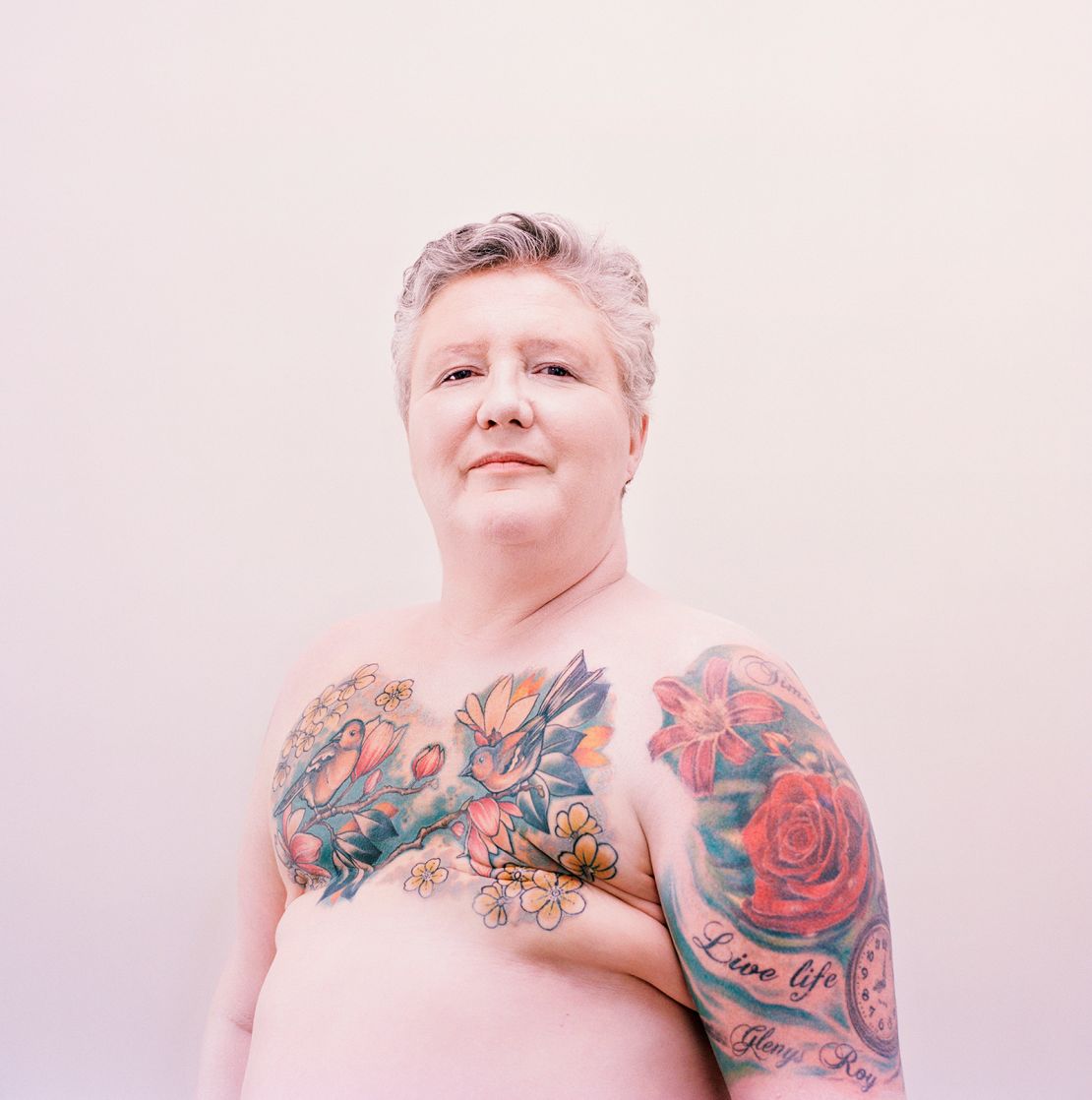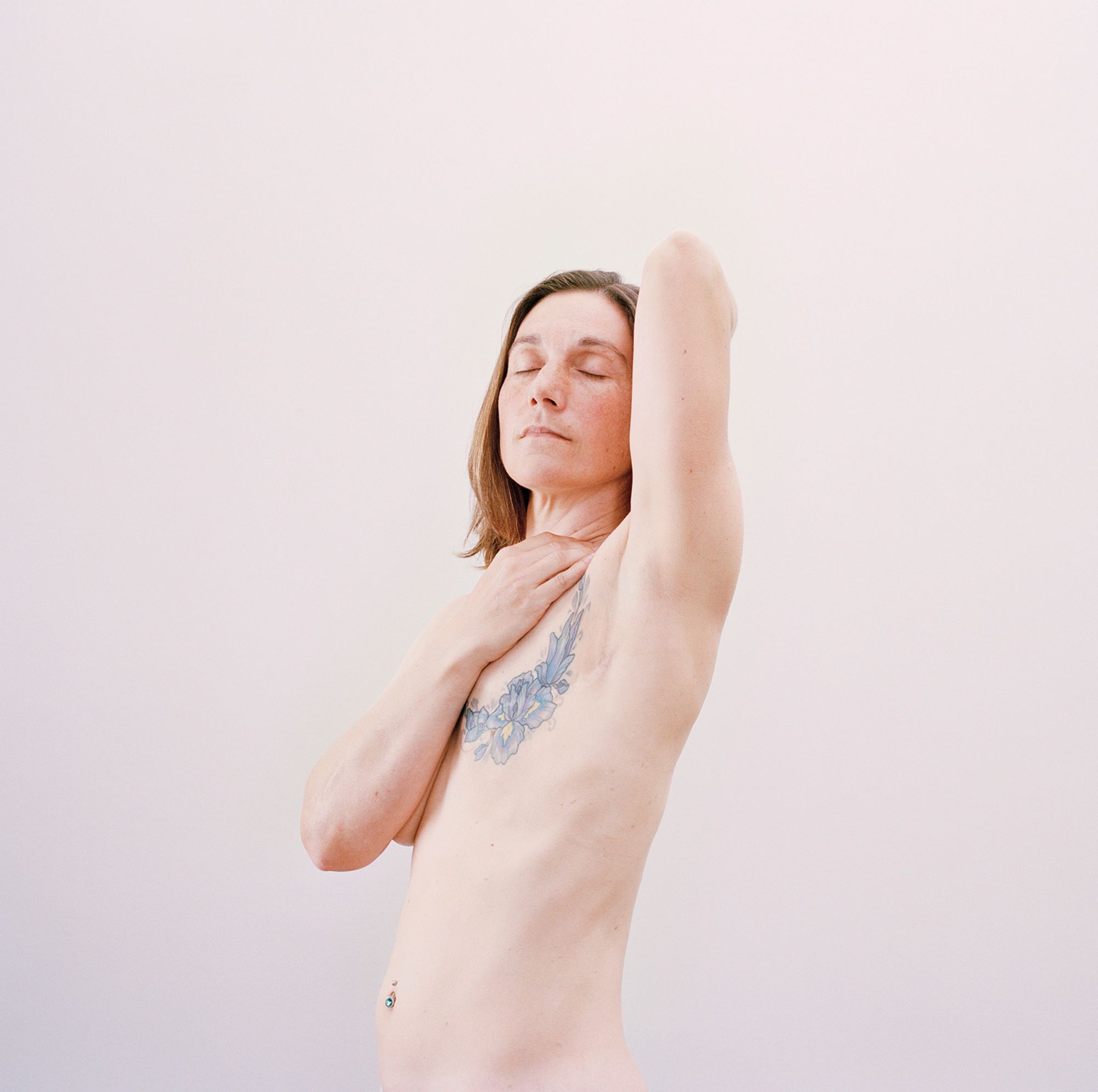In the portrait series “Reclaim” women in diffuse pink lighting reveal delicately tattooed designs inked across their chests, unfurling over scar tissue in explosions of color or in black and gray. Nude, with nothing else in the frame, the women embody a sense of openness.
The series, a collaboration between British photographer Kate Peters and art director Gem Fletcher, which began in 2018, illustrates the beauty of mastectomy tattoos, a practice that offers breast cancer survivors the opportunity to transform their skin after they’ve healed from their surgeries. It’s a way to find new confidence, to take control of one’s body after what can be a traumatic experience and, as medical journal JAMA has published, a way to promote psychological healing.

One of the women in “Reclaim” is Kerry, who was diagnosed with cancer three days before her 40th birthday. She opted for a total mastectomy of her left breast, but declined plastic surgery to reconstruct it after.
Ahead of each shoot, Peters and Fletcher interviewed the women about their experiences. “None of the methods for reconstruction that the medical team could offer me were suitable for me, my physique, my lifestyle and the sports I played,” Kerry told them. “It left me with a feeling of being incomplete and I found that really upsetting. You sort of get chewed up, spat out and off you go on your own.”
Two years later, when Kerry discovered mastectomy tattoos, she felt she finally had an option that suited her. She had irises tattooed across her chest as a tribute to her grandmother Iris, who survived breast cancer over six decades earlier.
The practice has risen in popularity in the US since 2013, when the program P.ink, part of the nonprofit F*** Cancer, began coordinating an annual day of gratis tattoos. Each October, during Breast Cancer Awareness Month, they work with tattoo parlors around the country to open their doors to survivors looking to be inked.
In 2018, Peters happened upon images of mastectomy tattoos on Instagram and realized that these were mostly shared within the tattoo community and did not have a wide audience. In her home country of the UK, which does not have a coordinated program like P.ink, she wasn’t sure many women knew about these tattoos at all.

Peters and Fletcher, who often collaborate, began finding women for the shoot through social media and photographed them in the privacy of Peters’ home. Many of them had never been tattooed, but going through the process had given them a sense of closure – particularly since they had to wait at least a year to be tattooed following their surgeries – and comfort in their skin.
“Hearing the women’s stories when we were photographing them was a very humbling experience, and seeing how the tattoos had changed their perception of their own bodies,” Peters said. “They were really keen to share how positive it had been for them.”
There was Elaine, who was diagnosed in October of 2015 and had a bilateral mastectomy a few months later. “I can picture it now, the morning I was leaving home to have the surgery and I looked at myself in the mirror…I knew I would not look like this again after that day,” she recalled to Peters and Fletcher. “It was a daunting thought, it was upsetting. When you have a mastectomy, a lot of your femininity (is) taken away.”
Elaine already had tattoos – including a dragon on her spine that she got after recovering from a horse-riding accident that could have left her unable to walk for the rest of her life. This time she spent 25 hours with Shrewsbury, England-based tattoo artist Anna Garvey to cover her chest in vivid birds and floral blossoms.

Sarah, on the other hand, who was diagnosed at 47 during a routine mammogram, had never been inked. She chose to have her breasts reconstructed following the mastectomy. During the reconstruction surgery, women often have to have their nipples removed, and some opt for tattooed areolas later on. Sarah didn’t feel like that was the right decision for her. Instead, she underwent two full-day sessions of intricate gray dotwork with East London tattooer and artist Dominique Holmes.
“The morning before (my tattoo appointment) I was in a state of panic about it, wondering if I had already put my body through so much already,” she said in her interview ahead of her shoot. “I took a before shot (of myself) and I felt really okay with my mastectomy and the scarring. I thought I felt okay about my body.” After her sessions, she says saw her body in a new light.
“Having the tattoo has not just changed the way my body looks – the bigger part is how it transformed me,” she explained. “I’m more body confident than I have been my entire life.”
After the photos from “Reclaim” were published by The Guardian newspaper, Peters said she was inundated with emails from people who had seen the work and didn’t know mastectomy tattoos were possible – including women who had undergone surgery and were interested in it for themselves.
“I think that was one of the main motivations for the women being involved in this shoot,” Peters said. “(They wanted) to show other people (how) it helped change their lives.”
“All of them have been through these horrific experiences in their life yet they’d all come through it and they were all so incredibly positive,” she continued. “They maintain this amazing spirit…and this desire to help others by sharing their stories.”
